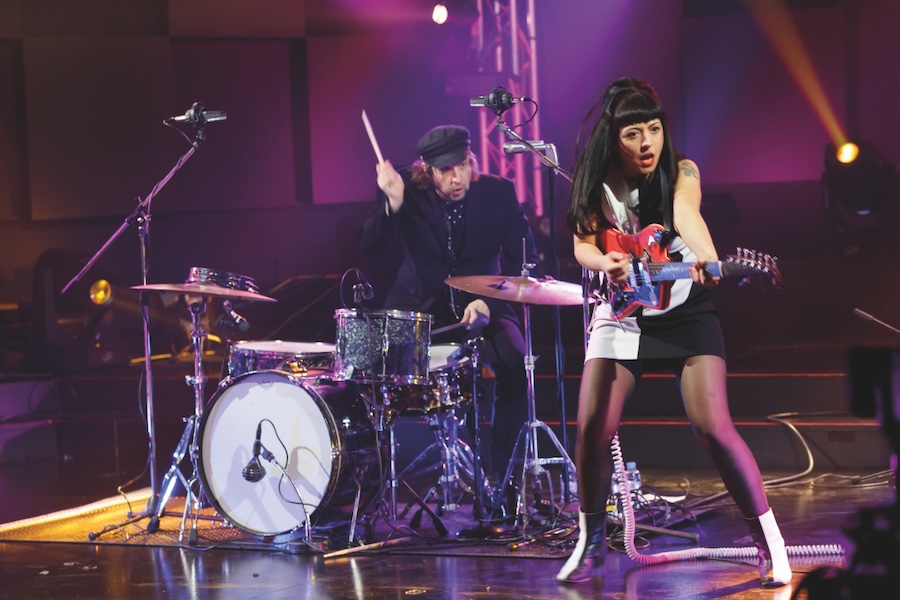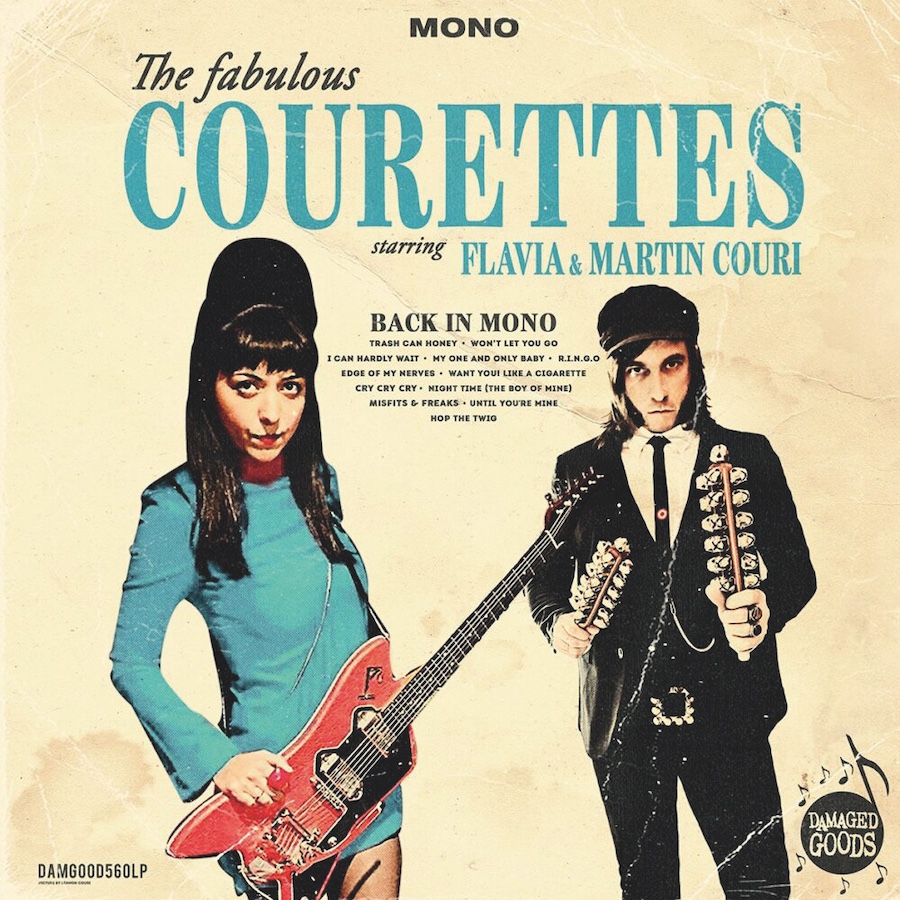Blend girl-group melodies, garage-rock ferocity and a mysterious Japanese mixing genius together with Phil Spector’s Wall of Sound and the result is the irresistible musical alchemy of The Courettes. By David West
“We knew it was incredible,” says Martin Couri about the very first time he made music with his wife Flavia, before they were married and their Danish-Brazilian power duo The Courettes was even the inkling of an idea. Flavia was visiting Martin in Aalborg, Denmark, when he suggested they go into a local studio for a jam.
“It was just an explosion of sound, we were both super amazed by what happened, because we’d been playing for many years, but we’d never had this chemistry. Where it came from, we have no idea,” he says.
“We played four songs and it just sounded remarkable. From the first chord, it was like, wow! – we realised that it was something special,” says Flavia. “We didn’t have any expectations at all. The songs just came, and we never sat down and said, ‘Shall we form a band?’ I think it was supposed to be.”
With Flavia on guitar and Martin on drums, The Courettes’ music inhabits the happy land between 60s girl groups and garage rock, equal parts sweet and salty. They’d both been in bands before, Flavia in Brazil and Martin in Denmark, but the fact that there’s something special about The Courettes has been evident from the outset.
Their first proper gig as a duo was in a pub in Aalborg where Kim Kix, from Danish country rockers Powersolo, was on the bill. “Kim loved us,” says Flavia. “He said, ‘I want to record you guys in my studio, what do you say, next week?’ ‘Okay!’ The first album has eight songs because those were the eight songs we had and that was it.”
That was 2015’s Here Are The Courettes, a jolt of lo-fi, unadulterated energy. We Are The Courettes followed in 2018 and after two records embracing rough-and-ready garage rock, the couple wanted to expand their sound into something bigger. Much bigger. So, for 2021’s Back In Mono, they built their own studio.
“In 2019 we spent all the money we had on building our Starrsound Studios, because we knew we wanted to do the Back In Mono record and recreate the Phil Spector Gold Star Studios Wall of Sound,” says Martin. “Of course, we couldn’t buy the same gear as back then, but we found weird, obscure German, Dutch and Swedish outboard effects, mixing desks and reverbs. But it’s better designed, it’s a better sound, the vintage stuff.”
Flavia recalls that 2019 was, “a good year for the band,” and they were all primed for 2020. “We had more shows booked, festivals… we were working on a new album. ‘Let’s put all our money into the studio, it’s going to be fine’, and then in March everything was cancelled.” With the duo realising that they’d lost their ability to earn via gigs, making the most of their new studio became a financial lifeline. “That was the beginning of Back In Mono,” adds Flavia.
It was no small undertaking and a considerable financial risk. “We knew it was going to cost a lot, but didn’t know how much,” says Martin. “Just the amount of money on buying cables was mind-blowing.” Not doing anything by halves, they even built an echo chamber. “In one side of the room there are 10 speakers, then a microphone at the other end of the room,” says Martin. “Luckily, this room just sounded amazing. It’s a real echo chamber, no plug-ins, no nothing. It’s real sound.”

Prior to Back In Mono, the duo had always hesitated to get into overdubs and multitracking, because they didn’t want the albums to offer a completely different experience to their live shows.
“We don’t want to be a duo that has a five-piece band backing them up onstage, or that the songs sound like sh*t with a duo but the album sounds amazing,” says Flavia. “On the first album especially, we did some vocals, a little bit of guitar, some tambourines, and that was it. It was raw and live in the studio.”
With Back In Mono, they wanted to capture the full Wall of Sound-experience, so they brought in their friend Søren Christensen as producer and co-writer. “He wrote the songs with us, he’s a fantastic producer. He was the first one operating the spaceship of our studio, so he knows all the tricks,” says Flavia.
“We had a great time in the studio. When we play the songs live, they just work. We were so relieved because we just found out that a good song is a good song. It can be an orchestra with 300 people playing, it can be you with a guitar by a bonfire, or you just sitting at the piano – if the song is good, it will work.”
Back In Mono is a quantum leap forward for the duo’s sonic identity, and they acknowledge that it was a risk, putting their lo-fi garage credentials on the line in pursuit of the Wall of Sound. “Maybe the diehard garage heads are going to think, ‘Ooh, maybe now they’re too pop,’” says Flavia. “We didn’t know, but we don’t care either because we don’t do music to please people, otherwise we’d be doing pop. We’d be doing something else if we wanted to please the masses.”
The gamble paid off. Back In Mono was acclaimed by critics, embraced by fans, and now here comes the sequel, Back In Mono (B-Sides & Outtakes), picking up where they left off. The A-side of the 10″ LP contains four new tracks: Daydream, Tough Like That, Talking About My Baby, and Last Dance With You.
On the flipside are three tracks, originally the B-sides of singles, Only Happy When You’re Gone, Killer Eyes, The Boy I Love, and So What, previously only available on a split 7″ with The Jackets on Portugal’s Chaputa! Records. The 10″ offers a fresh take on the tunes with all the songs remixed by Seiki Sato, the Japanese sound wizard who mixed Back In Mono.
They found Sato through a rather circuitous path. In 2019, The Courettes released the holiday single Christmas
(I Can Hardly Wait) – their first attempt to create the Wall of Sound in their studio. The track was selected for a Christmas Top Ten playlist alongside a single by Japanese singer Soleil.
“It’s so funny because it was the only song on the list we listened to,” says Martin. “We clicked the link and then BOOM, a gigantic wall of sound. I turned it off after five seconds, I was so p*ssed off.”
“He was depressed for weeks after,” confirms Flavia. “She’s a Japanese girl, she’s like 15, a teenager. She totally kicked our asses with her sound.” With the help of a music blog, they tracked down the song’s mixer, Seiki Sato, although since Sato doesn’t speak English and they don’t speak Japanese, all the communication was done via Sato’s assistant – they’ve never met the mixer or even seen his face. “It’s funny, sometimes we’re wondering, is he like a 16-year-old nerd, or is he in his 70s sitting in the hills?” says Flavia.
 “I have this Kill Bill image where you walk up the stairs to the Shaolin Temple and he’s sitting there with monk’s clothes on,” adds Martin. “Seiki Sato is the only one in the world who can do this, I’m absolutely sure about it. The depth and perspective he can bring to the sound, my god…”
“I have this Kill Bill image where you walk up the stairs to the Shaolin Temple and he’s sitting there with monk’s clothes on,” adds Martin. “Seiki Sato is the only one in the world who can do this, I’m absolutely sure about it. The depth and perspective he can bring to the sound, my god…”
With Starrsound fully operational, The Courettes have jumped back into live performance, taking their girl-group garage rock out to the world, back onstage where they belong. While they stayed active, performing whenever restrictions eased, it felt like the world coming back to life at their first open-air show after the lockdowns.
“It was a punk festival,” says Flavia. “To see the crowd pogoing, all these young people there having a good time, I almost cried. It’s great to be back. It’s more than just playing gigs, it’s this community of misfits and freaks.”
Top photo by Morten Madsen






